A stability-indicating HPLC procedure for determination of diltiazem hydrochloride in extemporaneously compounded oral liquids
Pharmaceutical Technology Europe
The stability of drugs in solid forms such as powders, tablets and capsules is usually determined very thoroughly by the drug's manufacturer. Based on stability study data, the shelf-life of a drug substance or a drug product is assigned. In addition to dispensing solid dosage forms to patients, pharmacists are frequently asked to compound oral liquid preparations for which the shelf-life or beyond-use date are assigned based on the pharmacist's best judgment - often without the benefit of stability data.
The stability of drugs in solid forms such as powders, tablets and capsules is usually determined very thoroughly by the drug's manufacturer. Based on stability study data, the shelf-life of a drug substance or a drug product is assigned. In addition to dispensing solid dosage forms to patients, pharmacists are frequently asked to compound oral liquid preparations for which the shelf-life or beyond-use date are assigned based on the pharmacist's best judgment — often without the benefit of stability data.
Liquid oral forms are in great demand for treating paediatric and geriatric patients who have difficulty swallowing solid oral dosage forms and for people with unique health needs that off-the-shelf prescription medicines cannot meet. Because compounded medications are a vital part of quality medical care, the drug stability information in liquid formulae must be available to compounding pharmacists so that they can assign a beyond-use date to compounded medicines.
Based on an informal survey mailed in 1994 to community and hospital pharmacies, the US Pharmacopeia (USP) Compounding Pharmacy Expert Committee developed a list of frequently compounded drugs and their concentrations in extemporaneously compounded oral liquids.1 Diltiazem HCl was among the drugs identified by the survey.
This article describes the development and validation of a stability-indicating HPLC procedure for the determination of diltiazem HCl in diltiazem HCl oral suspension and diltiazem HCl oral suspension, sugar free. The development of a stability-indicating HPLC procedure for the determination of diltiazem HCl in extemporaneously compounded oral liquids was based on the United States Pharmacopeia–National Formulary (USP–NF) monographs2,3 and on published findings of Allen and Erickson III.1 Both diltiazem HCl oral suspension and diltiazem HCl oral suspension, sugar free, were prepared from commercially available diltiazem HCl powder in a 1:1 (v/v) mixture of vehicle for oral solution and vehicle for oral suspension,4,5 and in a 1:1 (v/v) mixture of vehicle for oral solution, sugar free,6 and vehicle for oral suspension, respectively.
Experimental
Chemicals. USP diltiazem HCl reference standard (RS); USP desacetyl diltiazem HCl reference standard (RS) (Rockville, MD, USA); diltiazem HCl; microcrystalline cellulose; xanthan gum; carrageenan; carboxymethylcellulose sodium; citric acid; diabasic sodium phosphate; simethicone; potassium sorbate; methylparaben; sucrose; glycerin; sorbitol and sorbitol solution; saccharin sodium; and sodium citrate were from Spectrum Chemicals (New Brunswick, NJ, USA); d-10-camphorsulfonic acid was from ACROS (Geel, Belgium); sodium acetate and 0.1 N sodium hydroxide solution were from J.T. Baker (Phillipsburg, NJ, USA); hydrochloric acid and acetonitrile were from Fisher (Pittsburg, PA, USA); hydrogen peroxide was from Sigma (Saint Louis, MO, USA); methanol was from B&J Brand (Morristown, NJ, USA); and deionized water was obtained on Milli-Q reagent water system by Millipore. All vehicle ingredients were USP–NF grade. All chemicals were reagent grade or better.
HPLC system. The Agilent 1100 Series included a quaternary pump, autosampler, diode array UV detector, vacuum degasser, Chemstation chromatographic software and Waters μ-Bondapak C18 (30 cm=3.9 mm, 5 μm) or Phenomenex Bondeclone 10 C18 (30 cm=3.9 mm, 10 μm). Injection volume was 10 μL. Flow rate 1.6 mL/min.
Mobile phase. The mobile phase was prepared by mixing acetonitrile, methanol and buffer (1:1:2, v/v/v). To prepare the buffer, 2.3 g of d-10-camphorsulfonic acid was dissolved in 2000 mL of 0.1 M sodium acetate and adjusted the pH to 6.2 by adding 0.1 N sodium hydroxide. 0.1 M sodium acetate was prepared by dissolving 27.2 g of sodium acetate in 2.0 L of water.
Vehicles and placebos. Vehicle for oral solution, vehicle for oral suspension and vehicle for oral solution, sugar free, were prepared as described in USP 29–NF 24. A 1:1 (v/v) mixture of vehicle for oral solution and vehicle for oral suspension can be also called Placebo 1. A 1:1 (v/v) mixture of vehicle for oral solution, sugar free, and vehicle for oral suspension can be also called Placebo 2.
Diltiazem HCl oral suspension 12 mg/mL (Formula 1). An amount (~1.2 g) of diltiazem HCl was transferred to a 120 mL oval plastic amber bottle and then 100 mL of Placebo 1 was added. The formula was manually agitated and sonicated for 15 min to promote diltiazem HCl dissolution. A stir bar was added, and the formula was stirred for at least 30 min.
Diltiazem HCl oral suspension 12 mg/mL (Formula 2). An amount (~1.2 g) of diltiazem HCl was transferred to a 120 mL oval plastic amber bottle and then 100 mL of Placebo 2 was added. The formula was manually agitated and sonicated for 15 min to promote diltiazem HCl dissolution. A stir bar was added, and the formula was stirred for at least 30 min.
Diluent. Mobile phase was used as diluent in all standard and sample preparations.
Standard solution. Six or 12 mg of USP diltiazem HCl RS previously dried for 2 h at 105 °C was transferred to a 5 mL or 10 mL low-actinic volumetric flask, respectively, dissolved in and diluted to the mark with diluent, and mixed well. The final concentration was approximately 1.2 mg/mL.
System suitability solution. Six or 12 mg of USP diltiazem HCl RS previously dried for 2 h at 105 °C and USP desacetyl dilatiazem HCl RS were transferred to a 5 mL or 10 mL low-actinic volumetric flask, respectively, dissolved in and diluted to the mark with diluent, and mixed well. The final concentration was approximately 1.2 mg/mL of diltiazem HCl and desacetyl diltiazem HCl each.
Sample assay preparation. A 5 mL aliquot of the desired suspension was pipetted into a 50 mL low-actinic volumetric flask. The flask was diluted to the mark with diluent and mixed well. A portion of each solution was poured into a 10 cm centrifuge tube and centrifuged for 10 min. The clear top layer was transferred to an HPLC vial for analysis. Final concentration was approximately 1.2 mg/mL of diltiazem HCl.
Linearity solutions. For the 70% to 130% range (set 1), varying amounts of USP diltiazem HCl RS were weighed into low-actinic 10 mL volumetric flasks and diluted to the mark with diluent to obtain the final concentrations of 0.843 mg/mL, 0.963 mg/mL, 1.204 mg/mL, 1.445 mg/mL and 1.566 mg/mL. Ten μL of each solution was injected once into the HPLC system. For the 0.1%–200% range (set 2), two solutions were prepared at 0.0125 mg/mL and 1.204 mg/mL from USP diltiazem HCl RS in diluent using 100 mL low-actinic volumetric flasks. Varying volumes of these solutions were injected once into the HPLC.
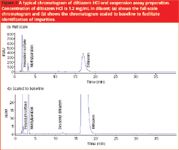
Figure 1
Accuracy and precision preparations. Six 5 mL aliquots each of Placebo 1 or Placebo 2 were pipetted into separate 50 mL low-actinic volumetric flasks. An amount (~42 or ~78 mg) of USP diltiazem HCl RS previously dried for 2 h at 105 °C was added to the flask. The flask was diluted to the mark with diluent and mixed well. A portion of each solution was poured into a 10 cm centrifuge tube and centrifuged for 10 min. The clear top layer was transferred to an HPLC vial for analysis. The final concentration of diltiazem HCl was approximately 0.84 or 1.56 mg/mL (70% or 130% of assay preparation concentration).
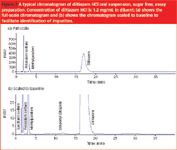
Figure 2
Methylparaben solution. A 10.0 mg portion of methylparaben was transferred to a 5 mL volumetric flask, dissolved in diluent, and diluted to the mark with diluent.

Table 1 Forced degradation results for diltiazem HCl oral suspension with peak purity values.
Saccharin sodium solution. A 5.0 mg portion of saccharin sodium was transferred to a 5 mL volumetric flask, dissolved in diluent and diluted to the mark with diluent.

Table 2 Forced degradation results for diltiazem HCl oral suspension sugar free, with peak purity values.
Potassium sorbate solution. A 10.3 mg portion of potassium sorbate was transferred to a 5 mL volumetric flask, dissolved in diluent and diluted to the mark with diluent.
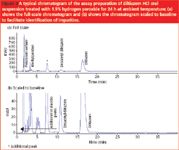
Figure 3
Results and discussion
Specificity. To establish that there was no interference from other vehicle components or degradation products in the stability-indicating ability of the procedure, individual optically active vehicle ingredients, both placebos and suspensions, were injected into the HPLC. Figures 1 and 2 depict typical chromatograms of the assay preparations of diltiazem HCl oral suspension and diltiazem HCl oral suspension, sugar free, respectively. The diltiazem peak was well resolved from the vehicle ingredients and the main degradation product, desacetyl diltiazem.

Table 3 Accuracy and precision results for diltiazem HCl in diltiazem HCl oral suspension (Formula 1) and diltiazem HCl oral suspension, sugar free (Formula 2).
To further evaluate the specificity of the procedure forced degradation studies were performed. For photochemical and thermal degradation studies, a 5 mL aliquot of each suspension and placebo was subjected to short-wave and long-wave ultraviolet and visible light and to 90 °C for 24 h. Acid-, base- and oxidizer-treated samples were prepared by mixing a 5 mL aliquot of each suspension and placebo with 5 mL of 0.1 N hydrochloric acid, 0.1 N sodium hydroxide and 3% hydrogen peroxide and letting them sit at ambient temperature for 24 h (Formula 1 was exposed only to base for 1 h). After degradation treatment, samples were allowed to cool to room temperature, if necessary. Acid- and base-treated samples were neutralized with an appropriate amount of 0.1 N sodium hydroxide and 0.1 N hydrochloric acid, respectively. All samples were prepared and analysed using the sample preparation procedure and the chromatographic conditions described in the experimental section. Diode array detection was employed for spectral purity analysis of the diltiazem peak in the stress samples over a range of 200–700 nm. The diltiazem peak was considered spectrally pure when the peak purity value was greater than 0.996. The area responses of diltiazem HCl in the stress samples were compared to those in the untreated samples and reported as percent diltiazem HCl concentration remaining. The results of the forced degradation study for both suspensions, including the peak purity values obtained by using the capability of the chromatographic software ChemStation, are shown in Tables 1 and 2.
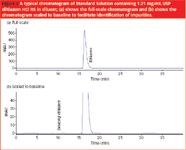
Figure 4
Both suspensions significantly degraded under all stress conditions except UV and visible light exposure. The greatest number of additional peaks, 10, was produced when an aliquot of either suspension was stressed with hydrogen peroxide solution. A typical chromatogram of a hydrogen peroxide–stressed suspension sample is shown in Figure 3. None of the detected additional peaks displayed retention times that overlapped the diltiazem peak under any stress condition. All of the diltiazem peaks had a peak purity value greater than 0.996 except Formula 1, which under basic stress conditions for ~1 h yielded a diltiazem peak purity of 0.9792. Adjustments in the HPLC conditions did not improve the diltiazem peak purity in the base-stressed sample. Also, there was no significant degradant peak observed at the retention time of diltiazem in the stressed placebos. Despite various stresses and degradation conditions the diltiazem peaks demonstrated spectral purity, which supports the use of this procedure to monitor the stability of diltiazem HCl oral suspension and diltiazem HCl oral suspension, sugar free.

Figure 5
Linearity. The range of the assay procedure was set at 70–130% of the diltiazem HCl label claim in the suspensions. Linearity of the detector response was investigated at five levels from 70% to 130% (set 1) and at seven levels covering a wider range from 0.1% to 200% (set 2) of the nominal assay sample concentration. A single injection of each of the linearity solutions was made and plots of peak area versus concentration were constructed. Linear regression was performed and the correlation coefficients were calculated. The correlation coefficients were 0.9995 (set 1) and 1.0000 (set 2) (desired correlation coefficient: ≥0.999). The percentage of the intercept relative to 100% analyte was in the range ±2% which is considered negligible.7,8 The range of the procedure was determined to be 0.0012–2.41 μg/mL (0.1%–200% of the nominal sample concentration of 1.2 mg/mL). Further ranges may be applicable but were not investigated.
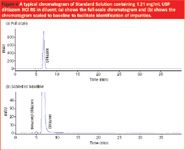
Figure 6
Accuracy and precision. The accuracy of the assay was demonstrated by spiking in triplicate freshly prepared Placebo 1 and Placebo 2 with known amounts of diltiazem HCl at 70% and 130% of the analyte nominal concentration. The final concentration of diltiazem HCl was approximately 0.84 or 1.56 mg/mL. The samples were analysed using a one-point external calibration. Individual and average recoveries were calculated and are reported in Table 3. All recoveries were in the 98.0–102.0% range. The procedure precision expressed as %RSD was evaluated for each spiking level and did not exceed 0.3%.
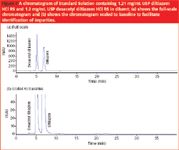
Figure 7
System suitability. The system suitability requirements were based on the requirements listed for the active pharmaceutical ingredient and tablet dosage form monographs for diltiazem HCl. These requirements included a relative standard deviation (RSD) for replicate Standard Solution injections of not more than 2.0% and an expected resolution of not less than 3 between desacetyl diltiazem and diltiazem peaks using the System Suitability Solution. The system suitability was established in all cases when the quantitative analysis was conducted. The results obtained on the Waters μ-Bondapak C18, 30 cm=3.9 mm, 5-μm column showed the instrument precision for 5 replicate injections for a period of 3 days did not exceed 0.12% RSD. The USP tailing factor for the diltiazem peak was approximately 1.7. Desacetyl diltiazem and diltiazem peaks were baseline separated with the lowest resolution value of 3.9. Typical chromatograms of Standard and System Suitability Solutions are presented in Figures 4 and 5, respectively.
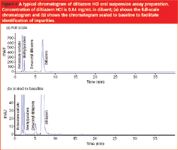
Figure 8
Ruggedness. The stability-indicating capability of the HPLC procedure was tested on an additional brand of a C18 analytical column (Phenomenex Bondeclone 10 C18 (30 cm=3.9 mm, 10 μm)). Freshly prepared Standard Solution and System Suitability solutions were analysed under normal operating conditions, and the results are shown in Figures 6 and 7. The RSD for five consecutive Standard Solution injections was 0.229%, and the resolution between desacetyl diltiazem and diltiazem using System Suitability Solution injections was 3.2. In addition to satisfying the system suitability conditions, the aged accuracy solution injections demonstrate that the placebo peaks did not interfere with the diltiazem peak, as shown in Figures 8 and 9.
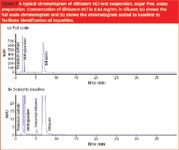
Figure 9
Conclusions
The HPLC procedure developed in this study was shown to be stability indicating, accurate, precise, and suitable for the determination of diltiazem HCl in diltiazem HCl oral suspension and diltiazem HCl oral suspension, sugar free. Sample preparation was straightforward and provided accurate results during stability studies.

Key points
Galina Holloway is a senior group leader for the analytical R&D laboratory for the US Pharmacopeia (Rockville, MD, USA). Galina has a PhD and 17 years' experience as an analytical chemist both in the US and Russia. She has headed a research laboratory on water quality for the Russian Academy of Sciences, been a senior analytical chemist for a major international pharmaceutical company, and been laboratory director of an independent smoke testing laboratory.
Heather Rowe-Joyce is a chemist IV for the analytical R&D and laboratory for the US Pharmacopeia.
Samir Z. Wahab is the director of the analytical R&D laboratory at the US Pharmacopeia. Previously, Samir worked at the Pharmaceutical R&D, Wyeth Consumer Healthcare (formerly Whitehall-Robins/American Home Products) in Richmond (VA, USA).
References
1. L. Allen Jr. and M. Erickson III, Am. J. Health-Syst. Pharm., 53, 2179–2184 (1996).
2. United States Pharmacopeial Convention, USP 29–NF 24, Diltiazem Hydrochloride (USP, Rockville, MD, USA, 2006) pp 714–715.
3. United States Pharmacopeial Convention, USP 29–NF 24, Diltiazem Hydrochloride Tablet (USP, Rockville, MD, USA, 2006) pp 719–720.
4. United States Pharmacopeial Convention, USP 29–NF 24, Vehicle for Oral Solution. Rockville (USP, Rockville, MD, USA, 2006) p 3455.
5. United States Pharmacopeial Convention, USP 29–NF 24, Vehicle for Oral Suspension (USP, Rockville, MD, USA, 2006) p 3456.
6. United States Pharmacopeial Convention, USP 29–NF 24, Vehicle for Oral Solution, Sugar Free (USP, Rockville, MD, USA, 2006) p 3456.
7. G.P. Carr and J.C. Wahlinch, J. Pharm. Biomed. Anal., 8, 613–618 (1990).
8. D.R Jenke, J. Liquid Chromatogr. Related Technol., 19(5), 737–757 (1996).

PacBio Chosen as Tech Partner for Global Alzheimer’s Disease Research Project
April 23rd 2025The project, the North African Dementia Registry, will unite multiple entities for the purpose of developing a comprehensive dataset to advance the research community’s understanding of Alzheimer’s disease and other dementias in diverse populations.
Drug Solutions Podcast: A Closer Look at mRNA in Oncology and Vaccines
April 30th 2024In this episode fo the Drug Solutions Podcast, etherna’s vice-president of Technology and Innovation, Stefaan De Koker, discusses the merits and challenges of using mRNA as the foundation for therapeutics in oncology as well as for vaccines.